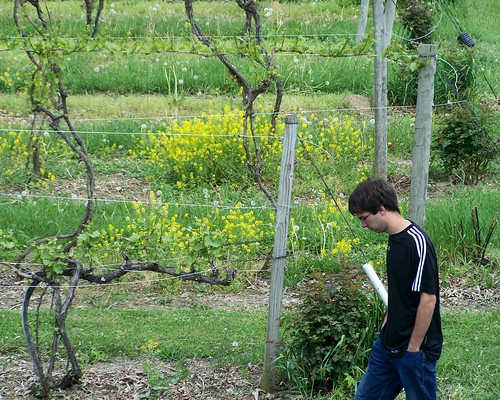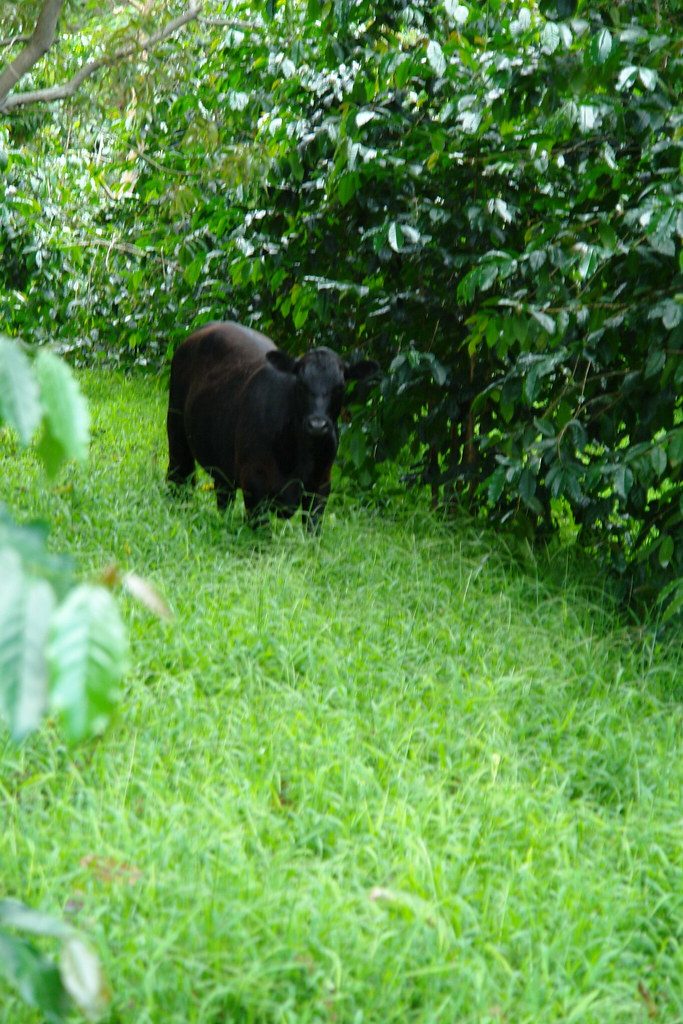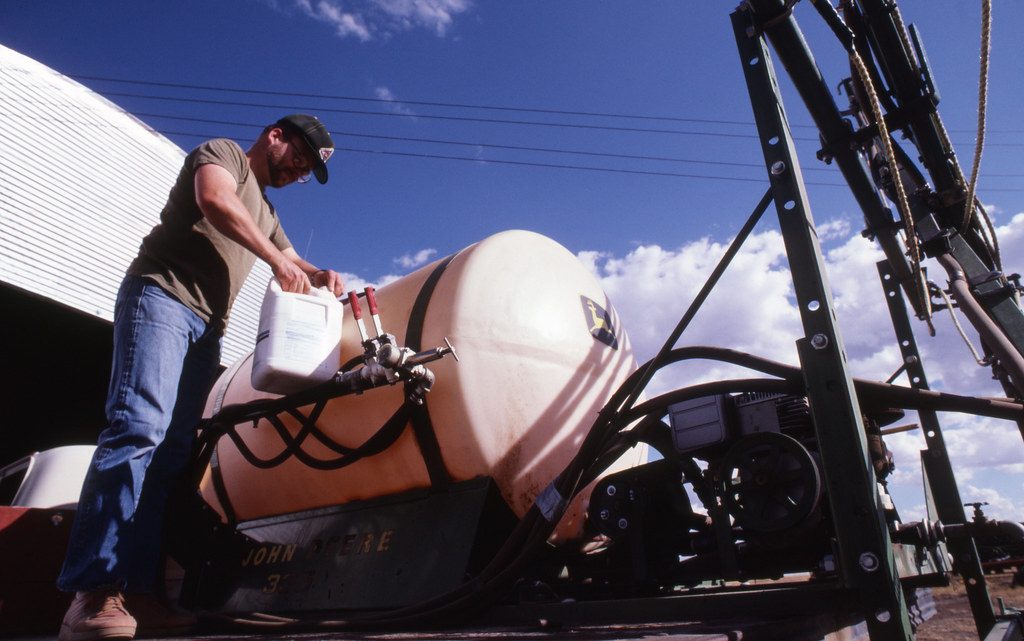The following is a guest post by Jolene Unland.
Jolene Unland is an agricultural scientist, originally from Kansas now living in Durham, North Carolina. Jolene has spent the past 20 years working in agriculture research and development. As grapes are grown in many of the same areas as other agricultural products, Jolene was drawn to grapes and wine through work travels. Wanting to learn more, she sought out to become a well informed wine consumer – by asking a lot of questions, reading, and then taking courses through the Wine and Spirit Education Trust (WSET). Today, she has the WSET Advanced Certification and is a French Wine Scholar. Jolene blogs over at KnowWines.com
Much of the wine produced today is through conventional farming, with a number of farmers moving toward sustainable farming. In the United States, both conventional and sustainable practices allow for the use of herbicides for controlling weeds.

“Mike by the vineyard” by jesiehart is licensed under CC BY 2.0
If a grower does not have a weed problem, then they do not need to use herbicides. However, weeds are a common problem that can not only reduce yields and make vineyard establishment problematic but can actually reduce the quality of the grapes produced. Uncontrolled weeds can also provide habitat for rodents and insects that can cause damage in the vineyard.
Many wine consumers are two or more generations removed from the farm and perhaps find it hard to understand why a vineyard management company or grape grower might use herbicides. Without spending some time in the vineyard, it is hard to understand the day to day challenges growers face when combating agricultural pests. The reason that herbicides are used is that their use is typically less expensive than physical removal by human labor and reduce potential erosion that can occur from mechanical tillage.
Because the number of companies developing herbicides is decreasing, it is also more unlikely to meet someone involved in the research, development and launch of these products. Here we describe how the development of a herbicide for use in vineyards typically occurs.
How are Weeds Controlled in the Vineyard?
Weeds are simply any plant growing out of place. Weeds may become problematic during key phases of the vineyard lifecycle. How the weeds are controlled is decided by the vineyard owner, manager or consultant. Options for controlling weeds can include cultivation or tillage, cover crops to out-compete weeds, mechanical means including by human hands, horse or oxen power, and herbicides.
It is not uncommon that there is more of a demand for herbicides from grape growers in the New World versus Europe. Many of the vineyards in the United States were grasslands or deserts until recently, or another crop like walnuts was growing on the land. When the original species or crops are removed to plant grapes, new flushes of weeds are common because the soil seed bank has been disrupted by all the human activity required to establish the vineyard. Whereas in well-established vineyards in Europe, the weed seed bank has likely been depleted over years and years of hand labor, mechanically, or with herbicides resulting in fewer weed seeds.
When a grape grower is having problems controlling weeds, there are a number of mechanical (tillage) and biological (grazing, cover crops) means they have typically attempted. However in specific situations, when the weeds cause economic pressure, the farmer can look toward herbicides to reduce yield loss from weeds. Another reason why a producer may seek out herbicides is that there are local regulations requiring them to control noxious weeds if they are present.

“DSC05648 weed control cows” by Plant pests and diseases is licensed under CC PDM 1.0
When weeds become difficult to control, the farmer or vineyard manager may seek recommendations from a number of people, including but not limited to fellow farmers, Cooperative Extension Agronomists, vineyard consultant, a sales or technical representative from a herbicide distributor or manufacturer.
Herbicide Research and Development
Due to the high cost and somewhat limited market (# of acres compared to broadacre crops like corn, wheat, soybean), it is highly unlikely that a herbicide is ever developed specifically for the control of weeds in vineyards. Developing a new herbicide takes roughly 10 to 14 years and $200 – 300 million USD.
Therefore, companies that develop new herbicides must be able to sell these products in other crops as well to recoup their investments. These companies recognize the need for newer herbicides to combat resistant weeds and grower needs. When economically justifiable (e.g. profitable) they will proceed with labeling a herbicide for use in grapes. A label is the EPA approved document that mandates how the herbicide may be used in the United States.
The shortest path to solving the grower’s weed issues is to seek out other herbicides in the companies portfolio that may be labeled in other horticulture or perennial crops, but not for grapes yet. These herbicides have already been researched and developed in other crops and grapes did not make it on the label. Technical scientists conduct controlled field trial experiments to see if there is a fit, then a proposal is made typically to expand the label.
Changing the label is not as easy as conducting a paper exercise – many studies and criteria must happen before the herbicide is allowed in grapes and before the producer can spray it on grapes, even if the herbicide is used in other crops. This takes years of research.
Biological Profile of a Herbicide
One of the primary tasks in developing a new herbicide or expanding the use of an existing herbicide to grapes is to develop a solid understanding of the biological activity of the herbicide. This takes a collection of many different types of field and lab experiments, including:
- Studying the application rate in grapes, and the herbicide rate needed to control the weeds and not damage the grapes
- Determining the effect of soil types on herbicide activity
- Testing different varieties of rootstocks upon which the noble grape varieties are grafted
- Testing under different irrigation practices of the region
- Evaluating the weed control during different times of the year (e.g. spring, summer or all year)
Herbicide Residue Studies
Specific field trials are conducted under GLP (Good Laboratory Practices) by herbicide companies, or through third party agriculture research organizations to set up controlled studies to measure herbicide residues in the target plant and harvested crop. In these carefully controlled studies, various portions of the plant are harvested (in this case, grapes) and analyzed in a laboratory for the herbicide that was applied.
The purpose of these studies is to find out how much of the herbicide and any metabolites (measured in ppm or ppb) remain in the plant, grape, wine, and soil. If the amount of residue is too high, then the herbicide will not be registered for use on grapes.
Herbicide Toxicology
Dose makes the poison. Even water and table salt are toxic at high enough levels. Specialized scientists (toxicologists) work at companies and at independent laboratories who help determine the dosage that could cause potential harm and sets the maximum use rates based on toxicological studies and required safety margins.
The toxicologist not only studies the potential impact on humans, but they also study the potential impact on the environment including target and non-target plants and non-target animals.
(An aside from Becca: GLP and “dose makes the poison” may not be appropriate in all cases. See an example here ).
Herbicide Labeling and Application
When toxicology and other studies are promising, technical agronomists will start to put out more controlled field experiments across a number of areas. The purpose is to dial in the use rate of the herbicide to control specific weeds or fine-tune it based on soil type or other agronomic factors.

“Machinery31.tif” by NRCS Montana is licensed under CC PDM 1.0
Each herbicide on the market has an EPA-approved label. A label is a document that designates the use rate, precautions, re-entry interval, soil type, what type of adjuvant to use with the herbicide so that it sticks to or penetrates the weed, crop type, and when the herbicide can be applied relative to harvest.
Once the rates have been defined and the new label goes live, the technical agronomists work with vineyard consultants and grape growers to try the new herbicide on their vineyard. The final moment of truth is the product on a producer’s farm in small scale tests before he/she decides to use the herbicide on a broader scale. They may try it on a few acres or one small vineyard the first year before expanding use to more of their vineyard.
Herbicide Performance Monitoring
Companies developing or selling herbicides and grape producers that use them have a vested interest in responsible stewardship of agrochemicals in the environment. These scientists and farmers are people just like you – who have families, friends, and pets and simply aspire to help farmers like grape growers raise a crop year after year and have meaningful and successful livelihoods.
Once the herbicide is on the market, a number of changes may happen that impact its usage.
- The herbicide might eventually be discontinued and taken off the market because it is no longer profitable for the company
- Over time, the herbicide active ingredient becomes generic, and other companies will introduce a new generic version
- Weeds can develop resistance to a herbicide. In the first years, the vineyard manager is happy that the weeds are controlled, but over time the herbicide is no longer effective because those weeds that could survive the herbicide propagated and took over.
Conclusion
In conclusion, growers sometimes need to use herbicides to control weeds when other mechanical or biological agriculture practices have been exhausted. Herbicides are used by both conventional and sustainable farmers in the United States. When there is no weed pressure in a vineyard, a grower does not need to use herbicides. Herbicide use will continue to be a need as the costs of manual farm labor continue to increase.
While farmers (including grape growers) must control weeds that compete with their crops or suffer financial loss, there are not many companies investing in the development of new herbicides for grapes due to the high cost of the many steps involved in developing a new herbicide or expanding an existing herbicide label to vineyards.
Jolene Unland is an agricultural scientist, originally from Kansas now living in Durham, North Carolina. Jolene has spent the past 20 years working in agriculture research and development. As grapes are grown in many of the same areas as other agricultural products, Jolene was drawn to grapes and wine through work travels. Wanting to learn more, she sought out to become a well informed wine consumer – by asking a lot of questions, reading, and then taking courses through the Wine and Spirit Education Trust (WSET). Today, she has the WSET Advanced Certification and is a French Wine Scholar. Jolene blogs over at KnowWines.com

2 comments for “How Herbicides are Developed for Vineyards – A Guest Post by Jolene Unland”